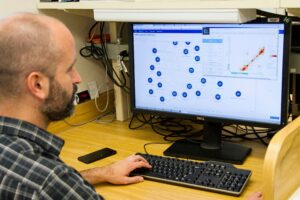
When the Square Kilometre Array (SKA) Observatory goes online later this decade, it will present one of the most significant data challenges in the history of science. Situated in the Southern Hemisphere, the SKA Observatory is a global radio telescope project that promises unprecedented views of our Milky Way, thanks to its strategic placement in remote areas that minimize human-made radio interference.
The project spans two sites: around 131,000 Christmas-tree-shaped antennas are being constructed in Western Australia, while 200 large dish antennas are being set up in the Karoo region of South Africa. As part of this international collaboration, Canada has established a data-processing center at the University of Victoria, marking a significant step in the global effort to manage the SKA’s data.
Unprecedented Data Volumes
The SKA Observatory is expected to generate approximately 600 petabytes of data annually. To put this into perspective, downloading this amount of data using a typical home internet connection of 100 megabytes per second would take about 200 years. This data volume surpasses even that produced by the Large Hadron Collider, often hailed as the world’s leading big data science project.
Among its ambitious research aims, the SKA will detect faint radio signals from the Cosmic Dawn, a period roughly 50 million to one billion years after the Big Bang, when the first stars and galaxies illuminated the universe. Additionally, the SKA will test Albert Einstein’s theory of general relativity by precisely timing signals from pulsars, which are rapidly spinning neutron stars.
Understanding the Cosmos
Another key goal of the SKA is to understand fast radio bursts—brief, intense radio pulses from distant sources. The SKA is expected to detect these bursts far more frequently than current instruments, providing a substantial dataset to help determine their origins, building on the work of facilities like Canada’s CHIME telescope.
Initial data from the SKA is anticipated in 2027, with major science operations commencing in 2029 as the array is constructed and commissioned in phases.
Canada’s Strategic Role
Handling the immense volume and complexity of SKA data necessitates a global network of specialized computing facilities, collectively known as SKA Regional Centres (SRCs). Canada joined the SKA Observatory research project in 2024 and soon committed to establishing one such center.
The Canadian SRC (CanSRC) will be the only SRC in the Americas, serving as a crucial node for processing, storing, and providing streamlined access to SKA data. This infrastructure will enable researchers to concentrate on scientific analysis rather than data management challenges.
Big Science Collaboration
The SKA is a testament to astronomy’s shift towards “Big Science,” where international collaboration becomes essential for scientific breakthroughs. This large-scale approach not only transforms how science is funded but also how it is conducted. While the SKA will still accommodate traditional investigator-led proposals, the majority of its observing power will be dedicated to ambitious, multi-year projects designed by large international teams.
Canadian researchers are actively involved in all of the SKA Science Working Groups and have co-chaired four of them in recent years. Canada is recognized as a world leader in studies of pulsars, cosmic magnetism, and transients, as well as in low-frequency cosmology—areas where the SKA is expected to make some of its most transformative discoveries.
Astronomical Data Management
Building, developing, and managing CanSRC requires collaboration among several Canadian institutions. The National Research Council’s Canadian Astronomy Data Centre, with four decades of experience in astronomical data management, plays a pivotal role. The Digital Research Alliance of Canada provides high-performance computing resources, while CANARIE operates the high-speed research network for data transfer. The University of Victoria’s Arbutus cloud platform supplies the scalable infrastructure needed for this endeavor.
The project leverages expertise concentrated within the University of Victoria’s Astronomy Research Centre, which brings together researchers from the University of Victoria, the National Research Council Herzberg Astronomy and Astrophysics Research Centre, and TRIUMF, Canada’s national particle accelerator centre.
Importantly, CanSRC ensures that researchers have access to SKA data. The capabilities developed through CanSRC will strengthen Canada’s digital ecosystem for the future.
Digital Discovery and Future Prospects
CanSRC will serve as a gateway for developing and expanding the use of advanced data methods and algorithms, helping scientists from both research and industry sectors harness massive datasets. This initiative not only promises to enhance our understanding of the universe but also to push the boundaries of digital innovation and data science.
As the SKA Observatory edges closer to becoming operational, the global scientific community eagerly anticipates the groundbreaking discoveries it will enable. The collaboration and infrastructure being developed today will lay the groundwork for the next generation of astronomical research and innovation.





